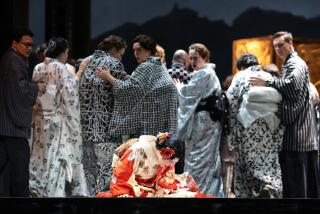‘The Magic Flute,’ South Africa style, heads for the Broad Stage
- Share via
“The Magic Flute” has received numerous modern and nontraditional interpretations over the years, but few have been as radical as the staging by South Africa’s Isango Ensemble, which has given Mozart’s opera of sorcery and romance a new spin with indigenous costumes and marimbas in place of an orchestra.
The idea for the staging came from an unlikely source, according to Mark Dornford-May, the co-founder of Isango and the director of the production.
“It came from a 9-year-old boy,” he recalled in a recent phone interview from South Africa. “He was watching another [of our] shows and said that we should do ‘The Magic Flute.’ I sort of laughed.”
Fall arts preview 2014: The season in music, theater and more
But the more the director thought of it, the more it made sense. In many ways, he said, the opera is “peculiarly South African” in its themes of people moving toward redemption, forgiveness and going through struggle to achieve peace.
Isango’s production, which is touring the U.S. this fall and is scheduled to run Oct. 8 to 12 at the Broad Stage in Santa Monica, isn’t an overtly political interpretation. “All the politics are with a lowercase p,” said Dornford-May. “You won’t see flags or symbols in the show that have relevance to a political movement.”
In 2005, Dornford-May directed the movie “U-Carmen e-Khayelitsha,” an adaptation of the popular Bizet opera set in modern-day South Africa and performed in the Xhosa language. The movie won the prize for best picture at the Berlin International Film Festival.
“The Magic Flute” will be performed in English by a 33-member cast that pulls double duty as marimba musicians. The Masonic rituals depicted in Mozart’s original opera have been replaced with various South African ceremonies. The flute played by the character Tamino is evoked by a trumpet.
Dornford-May said the staging allows “the vaudeville elements [of the opera] to come out.” (Mozart originally conceived the opera as a piece for the lowbrow vaudeville theater.) “It’s not in the sense that people are wearing vaudeville outfits, but there are turns and tricks, and actors respond directly to the audience.”
Twitter: @DavidNgLAT
More to Read
The biggest entertainment stories
Get our big stories about Hollywood, film, television, music, arts, culture and more right in your inbox as soon as they publish.
You may occasionally receive promotional content from the Los Angeles Times.











